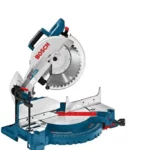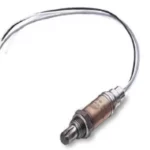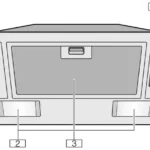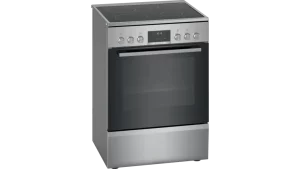

Bosch Electric Ovens
 Bosch Electric Ovens User Manual
Bosch Electric Ovens User Manual
Manuals of Different Ovens:
- BOSCH BFL523MS0B Microwave Oven User Manual
- BOSCH FFL023M… Microwave Oven User Manual
- BOSCH FFL020M… Microwave Oven User Manual
Bosch Electric Ovens IMPORTANT: This reference guide is not a substitute for the Use & Care manual. Read and consult the appliance Use & Care manual for important safety messages and additional information regarding the use of your new appliance.
Prepare the Oven for Use
Set the Clock
See detailed instructions in your appliance’s Use and Care manual. The procedure varies by the appliance.
Perform a before-first-use cleaning
- Wipe the oven interior with a clean, damp cloth using a mild dish detergent and wipe dry.
- To further reduce first-use odor, run a 30-minute bake cycle at 350° F.
User Settings
Consult the Use & Care manual “User Settings” to set 12/24 hour clock mode, Fahrenheit/Celsius temperature display, touchpad sound, show clock, oven temperature offset, and auto convection (select models only).
Oven Racks
- Do not handle the rack when it is hot. Make sure the oven rack is in the desired position before preheating the oven.
- The oven has six rack position guides numbered 1 to 6 starting from the bottom.
- Refer to the table below or the cooking charts in your appliance’s Use & Care manual for rack position to use when baking.
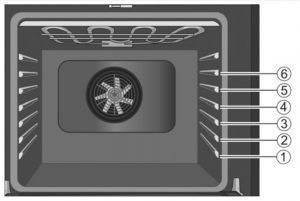
Rack Position Usage
Position Best For
- large roasts, turkey, angel food cake
- small roasts/poultry, bundt cakes, pies, breads
- broiling poultry, most baked goods on cooking sheet or baking pan, one rack, frozen convenience foods, cakes, casseroles, frozen pizza
- thicker meats
- toasting bread, broiling most meats, melting cheese
- hamburgers, steaks
Avoid Potential Damage to Oven Racks: Do not attempt to clean an oven rack using the oven’s Self-Clean feature. The intense heat will damage the rack’s finish and performance.
Inserting the Telescopic Rack
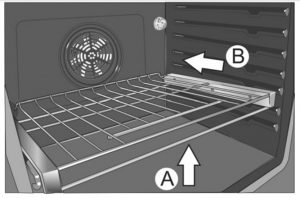
Hold the rack by both sides.
Slide it in above the position guide until the back of the rack is about 2 inches from the back of the oven. Tilt the front of the rack up slightly (A) and finish pushing the rack back (B).
The back of the rack drops into place. Pull the rack forward to seat the back onto the rack position guide.
Lower the front of the rack to finish seating it on the guide. The rack should be level and flat when properly inserted. Slide the moveable part of the rack in and out a few times to make sure the rack is securely anchored.
Oven Mode and Temperature
Setting the cooking mode and temperature
- Select the cooking mode you wish to use (see the cooking mode chart on the next page for mode descriptions).
- Accept or change the default temperature (See detailed instructions in your appliance’s Use and Care manual. The procedure used to change the oven temperature varies by appliance).
Allowed Temperature Range by Mode
- Mode: Lowest °F: Highest °F: Default °F
- Bake: 100: 550: 350
- Roast: 100: 550: 325
- Broil (low 450°; high 550°): 450 550 High
- Warm: 140: 225: 170
- Proof*: 85: 125: 100
- Convection Bake*: 100: 550: 325
- Convection Multi-Rack*: 100: 550: 325
- Convection Roast*: 100: 550: 325
- Pizza*: 100: 550: 400
- Convection Broil* (Low, High): 450: 550: High
- Frozen Foods*: 100: 550: 400
- EcoChef*: 100: 550: 325
* some models only
Mode Description and Usage
Oven Mode: Symbol Description Recommended Foods UsageTips
Bake:  Cooks with dry, heated air: Variety of foods, such as cakes, cookies, pastries, quick breads, quiche and casseroles: Best used with a single rack
Cooks with dry, heated air: Variety of foods, such as cakes, cookies, pastries, quick breads, quiche and casseroles: Best used with a single rack
Roast:  Uses more intense heat from upper
Uses more intense heat from upper
element, more browning of exterior: Best suited for meats, poultry, less tender cuts of meats and roasting vegetables: Preheat not necessary. Use for cooking bags and covered bakeware
Broil:  Uses intense heat radiated from the upper element:
Uses intense heat radiated from the upper element:
Tender cuts of meat (1″ or less), poultry, browning bread & casseroles Preheat oven 3 – 4 minutes. Use with rack in pan to drain fat away.Turn meat once
Warm:  Maintains a low temperature in order to keep food hot:
Maintains a low temperature in order to keep food hot:
Keeping cooked foods at serving temperature
To keep food moist, cover with lid or foil. To keep food dry, do not cover
Proof*: 
Convection Bake*: 
Convection Multi-Rack*: 
Circulates heat uniformly using fan and heating element in the back
Use for biscuits, cookies, cream puffs, cupcakes, dinner rolls, and muffins
Reduce temperature 25°F from recipe. Use for 2 and 3 racks of food
Convection Roast*: 
from upper element than Convection Bake with air circulated by a fan
Tender cuts of meat and poultry. Roasting vegetables. Meats are more juicy and moist than results with Roast mode Preheat not necessary. Use recipe/cooking chart temperature. Use open roasting pan with rack
Pizza*: 
Convection Broil*: 
element with fan circulation Tender cuts of meat (more than 1″), poultry and fish. Not for browning Preheat oven 3 – 4 minutes. Use with rack in pan to drain fat away.Turn meat once
Frozen Foods*: 
Eco Chef*: Uses residual heat to reduce energy consumption during cooking Tender cuts of meat and poultry Requires use of probe. Allow 5 – 10 minute stand time outside the oven

- Do not use the Warm mode to warm cold food. Maintain proper food temperature (USDA recommends 140°F or higher).
- DO NOT keep food warm for longer than 1 hour.
* available in some models
Pan Placement
Baking results are better if pans are placed in the center of the oven.
- Place a single pan in the center of the oven rack
- Allow 1” to 1 1/2” around pans
- Stagger pans if used on two racks so one pan is not above another
Baking Pans and Dishes
Use light anodized or shiny metal bakeware for tender, light, golden brown crusts. Dark, rough or dull pans absorb heat and will result in a browner, crisper crust. Follow the manufacturer’s recommendations in selecting baking temperatures.
Insulated cookie sheets or bakeware will increase the length of cooking time.
Use low-sided, uncovered pans for convection modes.
For Best Cooking Results
- Open the oven door as briefly as possible to avoid reducing the oven temperature.
- Use the interior oven light to view the food through the oven window rather than opening the door frequently.
- When using Convection baking modes (including MultiRack), set the oven temperature 25° lower than indicated in conventional baking recipes or package directions.
- Preheat the oven for baked goods and pizza.
Cooking Charts
Baked Goods
- Type: Food: Recommended Mode: Oven Temp.: No. of Racks:
- Rack Position(s): Cooking Time (minutes)
Cakes:
- Cupcakes: Bake: 350: 1: 4: 17 – 24
- Conv Multi Rack* 325 2 2 & 5 17 – 23
- Conv Multi Rack* 325 3 1, 3 & 5 17 – 23
- Cakes: Bake 350 1 3 23 – 31
- Convection Bake* 325 2 2 & 5 23 – 30
Cookies:
- Brownies: Bake: 350: 1: 3: 33 – 41
- Conv Bake: 32:5 1: 3: 33 – 40
- Cookies: Bake: 350: 1: 3
- Conv Multi Rack*: 325: 2: 2 & 5: 8 – 17
- Conv Multi Rack*: 325 3: 1, 3 & 5: 8 – 17
Breads:
- Biscuits/Muffins: Bake: 350: 1: 3 or 2: 12 – 20
- Conv Multi Rack*: 325 2: 2 & 5: 10 – 20
- Conv Multi Rack*: 325: 3: 1, 3 & 5: 10 – 20
- Quick Bread: Conv Bake: 350 1: 2: 48 – 60
- Yeast Bread: Conv Bake: 400: 1: 2: 22 – 35
Pie:
- Fruit, Fresh: Bake: 400: 1: 2: 35 – 50
- Pumpkin: Bake: 425: 1: 2: 15
- Bake: 350: 1: 2: 35 – 45
Pizza:
- Frozen, thin crust: Bake: 425: 1: 3: recipe time
- Frozen, thin crust: PIzza*: 425: 1: 3: recipe time
- Frozen, thick crust: Bake: 425: 1: 3: recipe time
- Frozen, thick crust: PIzza: 425: 1: 3: recipe time
- Fresh: Bake: 425: 1: 2: recipe time
- Fresh: Pizza: 425: 1: 2: recipe time
Entrees:
- Casseroles: Bake: 350 – 400: 1: 3: per recipe
- Frozen (nuggets, fish sticks, fries): Bake: per package: 1: 3: per package
- Frozen Foods*: per package: 1: 3: per package
- Garlic Bread: Broil: Low
- Quiche: Bake: 425: 1: 2
- Bake: 375: 1: 3
- Vegetables, roasted: Roast: 400 – 500: 1: 3: 15 – 30
- Conv Roast *: 400 – 500: 1: 3: 15 – 30
Troubleshooting
Before calling customer service, consult this troubleshooting guide. Customer education issues are not covered by the appliance warranty. Refer the the Use and Care manual for additional information.
Problem:
Possible Cause: Suggested Solution
Oven door is locked and will not open, even after cooling:
Circuit breaker tripped: Reset circuit breaker (turn off, wait five minutes, turn back on)
Oven is not heating: Power not reaching oven.
Temperature not set.: Restore power to oven. Select oven temperature.
Baking results not as expected: Rack position incorrect. Oven calibration needed for temperature offset.
See cooking tips in Use & Care manual.: Refer to cooking chart for correct rack position. Adjust oven calibration if necessary, see “Oven Temperature Offset” in Custom Settings.
Food takes longer to cook than expected or is overcooked: Oven temperature offset needed: Adjust oven calibration if necessary, see “Oven Temperature Offset” in Custom Settings.
Convection Bake or Conv. Multi-Rack (some models) results are not as expected: Oven temperature needs to be reduced by 25° F. Incorrect rack position, cooking time, pan selection. Oven calibration needed. Refer to cooking chart for correct rack position.: Adjust oven calibration if necessary, see “Oven Temperature Offset” in Custom Settings.
Oven temperature too hot or too coo:l Oven thermostat adjustment needed.: Adjust oven calibration if necessary, see “Oven Temperature Offset” in Custom Settings.
Oven light not working properly: Bulb loose or defective: Reinsert or replace the bulb (avoid touching bulb glass with fingers to avoid premature burnout due to oil deposits.)
Can not remove light lens cover: Soil buildup around lens cover. Lens catch not released.: Wipe lens cover area with a clean, dry towel prior to removing. Consult Use & Care manual for lens removal technique.
Oven is not self-cleaning properly: Oven was not cooled down prior to starting self clean.: Allow oven to cool down before running self clean. Wipe out loose soiling or spills before running self clean. If oven is badly soiled, set oven for the maximum self clean time.
“E” and a number appears in the display and the control panel emits a beep: This is a Fault Code. Press any key or turn selection dial to cancel beeping. To clear Fault Code: (500 Series) turn control knob to “Off” position, (800 Series) Press the oven On/Off button to turn the oven Off. If the fault code remains displayed, reset oven (turn off circuit breaker for 20 seconds). If still displayed, contact Customer Service.
Odor detected on new oven use: This is normal with a new oven.: Will disappear after a few uses. Wiping oven cavity out when cool and then running a self-clean cycle may help reduce the odor more quickly.
Control panel does not respond to key press: Center of key not pressed with flat part of fingertip.: Touch the center part of the touch key using the flat pad of a fingertip. Be sure the panel surface is clean and dry.
Conv. fan runs during modes that do not use convection: This is normal in some modes while the oven is preheating.: No action required if the fan runs during preheating in certain non-convection modes.
Warm air or steam is seen escaping from the oven vent: This is normal to see or feel steam or warm air coming from the oven vent.: No action required, do not block the vent.
Cooking fan runs after the oven is turned: “Off” This is normal. The fan aids in oven cooling.: No action required. The cooling fan will continue to run until the oven has cooled sufficiently.
Customer Service
Please check the troubleshooting pages in this guide before calling Customer Service. Commonly asked questions are addressed there and may resolve your issue the fastest. In the event you still need to contact Customer Service, there is some information you can have ready to speed up the process: 1) model & serial number 2) date of purchase.
Don’t forget to register your oven so you will receive notices, updates and offers as they become available. This also will help provide quick and efficient support for your specific unit.
Data plate shows model and serial number. It is visible with the oven door open. Consult your oven’s user manual for the specific label location.
FAQS
What is the difference between an oven and a compact oven?
Ovens:
An oven can be installed either under the worktop or ergonomically at eye level in a tall cupboard. A separate hob can be installed individually, independently of the oven.
Compact ovens:
Compact ovens with a recess size of 45 cm are ideal for ergonomic installation in a tall cupboard. You can replace an oven with a compact oven, supplement your oven with it or combine both. You can also combine a compact oven with an integrated microwave or with other convenient equipment.
What should I look out for when connecting up an oven?
For all of our ovens, an electrical connection will be required. We advise to seek professional guidance on the installation and connection of your oven, based on the appliance chosen and your specific circumstances.
What should I look out for when connecting up a compact oven?
With a new compact oven, you should check the dimensional drawing in the product overview. Remember to check the height, depth and width.
What are the combination options for a 60cm opening?
In a recess that is 60cm high, you can combine a 45cm high compact oven with a 14 cm warming drawer.
VIDEO
To contact customer service:
US: 800-944-2904
Web: www.bosch-home.com.us
Parts & Accessories: www.bosch-eshop.us
 Bosch Electric
Bosch Electric
